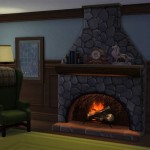Wood Fireplace Mantel Surround Plans: A Comprehensive Guide
A wood fireplace mantel surround serves as a focal point in a living space, blending aesthetic appeal with functional design. It frames the fireplace opening, adding architectural interest and providing a surface for decorative display. Choosing the right wood and constructing a well-designed mantel surround involves careful planning and execution. Understanding the available plans, the necessary materials, and the construction process is crucial for achieving a successful outcome.
The selection of a wood fireplace mantel surround plan is the first step in this project. Numerous designs are available, ranging from simple, minimalist styles to elaborate, ornate structures. Factors such as the overall décor of the room, the size of the fireplace, and the desired aesthetic should all be considered. Additionally, local building codes and fire safety regulations must be adhered to throughout the design and construction process.
Understanding Different Mantel Surround Styles
Mantel surrounds typically fall into several stylistic categories, each offering a distinct visual impact. Traditional mantels often feature intricate carvings, moldings, and corbels, evoking a sense of classic elegance. These designs are well-suited for homes with formal living spaces and period architecture. In contrast, contemporary mantels tend to be sleek and minimalist, utilizing clean lines and simple geometric shapes. They complement modern interiors and prioritize functionality over elaborate ornamentation. Rustic mantels, characterized by natural wood grains, exposed knots, and a rugged, unrefined appearance, are ideal for creating a cozy and inviting atmosphere. These mantels may incorporate reclaimed wood or feature distressed finishes to enhance their rustic charm. Finally, transitional mantels bridge the gap between traditional and contemporary styles, combining elements of both to create a balanced and versatile design. They often feature simplified moldings, subtle details, and a neutral color palette.
When selecting a style, it's important to consider the existing architectural details of the room and the overall design aesthetic. Opting for a mantel that complements the room's style will create a cohesive and visually appealing space. Conversely, choosing a mantel that clashes with the existing décor can disrupt the harmony of the room and detract from its overall aesthetic.
Key Considerations When Selecting Wood
The type of wood used in the mantel surround significantly impacts its appearance, durability, and cost. Hardwoods, such as oak, maple, and cherry, are known for their strength, density, and resistance to wear and tear. They are typically more expensive than softwoods, but they offer superior durability and aesthetic appeal. Softwoods, such as pine, fir, and cedar, are more affordable and easier to work with, but they are also more susceptible to dents and scratches. They are often used for painting or staining, as their natural grain patterns may not be as visually striking as those of hardwoods.
Beyond the type of wood, the grade and quality are also important considerations. Select grades of wood are free from knots and blemishes, offering a consistent and uniform appearance. Common grades of wood may contain knots and other imperfections, which can add character to the mantel but may also require additional preparation and finishing. Kiln-dried wood is recommended, as it has been dried to a specific moisture content, reducing the risk of warping or cracking over time. The choice of wood will also influence the finishing options. Some woods are better suited for staining, while others are more receptive to paint. Consider the desired final appearance and select a wood type and finish that are compatible.
Essential Steps in the Construction Process
Once a plan is selected and the materials are gathered, the construction process can begin. The initial step typically involves measuring and marking the lumber according to the chosen plan. Accurate measurements are crucial to ensure that the components fit together properly and that the mantel surround is properly aligned with the fireplace opening. After cutting the lumber, the pieces are assembled using wood glue and fasteners, such as screws or nails. Clamping the pieces together during the gluing process ensures a strong and durable bond.
After assembly, the mantel surround may require sanding and finishing to achieve the desired appearance. Sanding smooths the surface of the wood, removing any imperfections and preparing it for finishing. Finishing options include staining, painting, or applying a clear coat. Staining enhances the natural grain of the wood, while painting provides a uniform color finish. A clear coat protects the wood from moisture and scratches, extending its lifespan. Proper ventilation is essential during the finishing process, as many finishing products release harmful fumes. Multiple coats of finish may be required to achieve the desired level of protection and aesthetic appeal. Finally, the mantel surround is installed around the fireplace opening, ensuring that it is securely attached to the wall and that it meets all applicable building codes and fire safety regulations. This may involve using shims to ensure a level and plumb installation.
Careful planning, meticulous execution, and adherence to safety guidelines are essential for constructing a wood fireplace mantel surround that enhances both the aesthetic appeal and functionality of the living space. By understanding the available plans, selecting the appropriate materials, and following the construction process diligently, homeowners can create a beautiful and enduring focal point for their home.

Elite Construction Of Jax Inc Custom Decorative Mantels Fireplace Mantel Surrounds Molding Design

How To Build A Diy Fireplace Mantel Fixthisbuildthat

How To Build A Diy Fireplace Mantel Fixthisbuildthat

Easy Fireplace Mantel Diy

Building An Easy Modern Fireplace Mantel Young House Love
:max_bytes(150000):strip_icc()/ablossominglife-4151b41015a64193a437e981c3aad037.jpg?strip=all)
17 Diy Fireplace Mantel Plans

Diy Fireplace Mantel The Idea Room

How To Build A Shaker Fireplace Mantel And Surround Woodworking Diy Project Plans You Can Make It

Faux Fireplace Mantel Surround Rogue Engineer

Projects And Plans Exciting Room Updates By Decor Gold Designs Fireplace Remodel White Surround Tile








